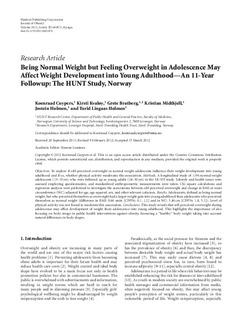| dc.contributor.author | Cuypers, Koenraad | |
| dc.contributor.author | Kvaløy, Kirsti | |
| dc.contributor.author | Bratberg, Grete Helen | |
| dc.contributor.author | Midthjell, Kristian | |
| dc.contributor.author | Holmen, Jostein | |
| dc.contributor.author | Holmen, Turid Lingaas | |
| dc.date.accessioned | 2017-11-17T09:42:52Z | |
| dc.date.available | 2017-11-17T09:42:52Z | |
| dc.date.created | 2013-01-21T20:50:06Z | |
| dc.date.issued | 2012 | |
| dc.identifier.citation | Journal of Obesity. 2012, . | nb_NO |
| dc.identifier.issn | 2090-0708 | |
| dc.identifier.uri | http://hdl.handle.net/11250/2466838 | |
| dc.description.abstract | Objectives. To explore if self-perceived overweight in normal weight adolescents influence their weight development into young adulthood and if so, whether physical activity moderates this association. Methods. A longitudinal study of 1196 normal weight adolescents (13–19 yrs) who were followed up as young adults (24–30 yrs) in the HUNT study. Lifestyle and health issues were assessed employing questionnaires, and standardized anthropometric measurements were taken. Chi square calculations and regression analyses were performed to investigate the associations between self-perceived overweight and change in BMI or waist circumference (WC) adjusted for age, age squared, sex, and other relevant cofactors. Results. Adolescents, defined as being normal weight, but who perceived themselves as overweight had a larger weight gain into young adulthood than adolescents who perceived themselves as normal weight (difference in BMI: 0.66 units [CI95%: 0.1, 1.2] and in WC: 3.46 cm [CI95%: 1.8, 5.1]). Level of physical activity was not found to moderate this association. Conclusions. This study reveals that self-perceived overweight during adolescence may affect development of weight from adolescence into young adulthood. This highlights the importance of also focusing on body image in public health interventions against obesity, favouring a “healthy” body weight taking into account natural differences in body shapes. | nb_NO |
| dc.language.iso | eng | nb_NO |
| dc.publisher | Hindawi Publishing Corporation | nb_NO |
| dc.rights | Navngivelse 4.0 Internasjonal | * |
| dc.rights.uri | http://creativecommons.org/licenses/by/4.0/deed.no | * |
| dc.title | Being normal weight, but feeling overweight in adolescence may effect weight development into young adulthood - An 11-year follow-up: The HUNT Study, Norway | nb_NO |
| dc.type | Journal article | nb_NO |
| dc.type | Peer reviewed | nb_NO |
| dc.description.version | publishedVersion | nb_NO |
| dc.source.pagenumber | 8 | nb_NO |
| dc.source.journal | Journal of Obesity | nb_NO |
| dc.identifier.doi | 10.1155/2012/601872 | |
| dc.identifier.cristin | 994680 | |
| dc.description.localcode | Copyright © 2012 Koenraad Cuypers et al. This is an open access article distributed under the Creative Commons Attribution License, which permits unrestricted use, distribution, and reproduction in any medium, provided the original work is properly cited. | nb_NO |
| cristin.unitcode | 194,65,20,0 | |
| cristin.unitname | Institutt for samfunnsmedisin og sykepleie | |
| cristin.ispublished | true | |
| cristin.fulltext | original | |
| cristin.qualitycode | 1 | |

